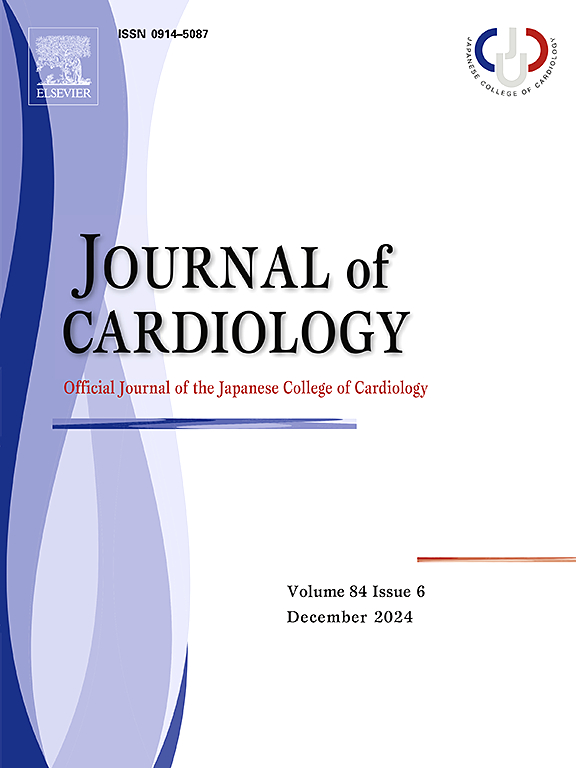Coronary bioresorbable metallic stents: Advancements and future perspectives
IF 2.6
3区 医学
Q2 CARDIAC & CARDIOVASCULAR SYSTEMS
引用次数: 0
Abstract
Percutaneous coronary intervention is a critical treatment for coronary artery disease, particularly myocardial infarction, and is highly recommended in clinical guidelines. Traditional metallic stents, although initially effective, remain permanently in the artery and can lead to complications such as in-stent restenosis, late thrombosis, and chronic inflammation. Given the temporary need for stenting and the potential for late complications, bioresorbable stents have emerged as a promising alternative. However, bioresorbable polymeric stents have encountered significant clinical challenges due to their low mechanical strength and ductility, which increase the risks of thrombosis and local inflammation. Consequently, bioresorbable metals are being considered as a superior option for coronary stents. This review examines the progress of bioresorbable metallic stents from both preclinical and clinical perspectives, aiming to provide a theoretical foundation for future research. Iron, zinc, and magnesium are the primary materials used for these stents. Zinc-based bioresorbable stents have shown promise in preclinical studies due to their biocompatibility and vascular protective properties, although human clinical studies are still limited. Magnesium-based stents have demonstrated positive clinical outcomes, being fully absorbed within 12 months and showing low rates of late lumen loss and target lesion failure at 6- and 12-months post-implantation. Initial trials of iron-based stents have indicated favorable mid-term safety and efficacy, with complete absorption by the body within three years and consistent luminal expansion beyond six months post-implantation. Despite these advancements, further trials are needed for comprehensive validation. In conclusion, while current materials do not fully meet the ideal requirements, ongoing research should focus on developing bioresorbable stents with enhanced performance characteristics to better meet clinical needs.
冠状动脉生物可吸收金属支架:进展与未来展望。
经皮冠状动脉介入治疗是冠状动脉疾病(尤其是心肌梗死)的重要治疗方法,也是临床指南强烈推荐的治疗方法。传统的金属支架虽然起初有效,但会永久留在动脉中,可能导致支架内再狭窄、晚期血栓形成和慢性炎症等并发症。考虑到支架植入的临时性和后期并发症的可能性,生物可吸收支架已成为一种很有前景的替代方案。然而,由于生物可吸收聚合物支架的机械强度和延展性较低,增加了血栓形成和局部炎症的风险,因此在临床上遇到了巨大挑战。因此,生物可吸收金属被认为是冠状动脉支架的最佳选择。本综述从临床前和临床角度探讨了生物可吸收金属支架的研究进展,旨在为未来的研究提供理论基础。铁、锌和镁是这些支架的主要材料。锌基生物可吸收支架因其生物相容性和血管保护特性,已在临床前研究中显示出良好的前景,但人类临床研究仍然有限。镁基支架的临床效果良好,可在 12 个月内被完全吸收,植入后 6 个月和 12 个月的晚期管腔损失率和靶病变失败率较低。铁基支架的初步试验表明,中期安全性和疗效良好,可在三年内被人体完全吸收,植入后 6 个月内腔道持续扩张。尽管取得了这些进展,但还需要进一步的试验来进行全面验证。总之,虽然目前的材料还不能完全满足理想的要求,但当前的研究应侧重于开发性能更强的生物可吸收支架,以更好地满足临床需求。
本文章由计算机程序翻译,如有差异,请以英文原文为准。
求助全文
约1分钟内获得全文
求助全文
来源期刊

Journal of cardiology
CARDIAC & CARDIOVASCULAR SYSTEMS-
CiteScore
4.90
自引率
8.00%
发文量
202
审稿时长
29 days
期刊介绍:
The official journal of the Japanese College of Cardiology is an international, English language, peer-reviewed journal publishing the latest findings in cardiovascular medicine. Journal of Cardiology (JC) aims to publish the highest-quality material covering original basic and clinical research on all aspects of cardiovascular disease. Topics covered include ischemic heart disease, cardiomyopathy, valvular heart disease, vascular disease, hypertension, arrhythmia, congenital heart disease, pharmacological and non-pharmacological treatment, new diagnostic techniques, and cardiovascular imaging. JC also publishes a selection of review articles, clinical trials, short communications, and important messages and letters to the editor.
 求助内容:
求助内容: 应助结果提醒方式:
应助结果提醒方式:


